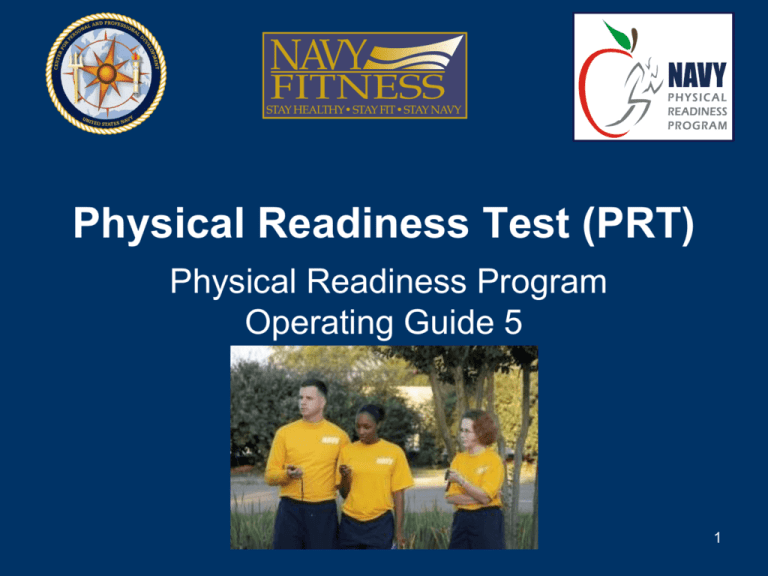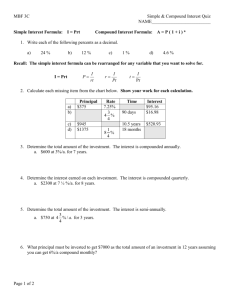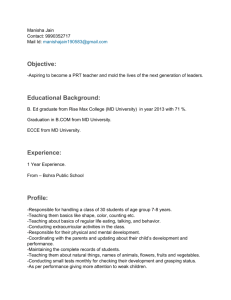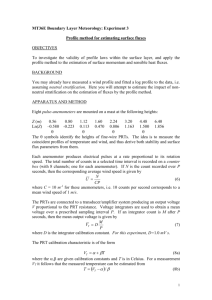CFL_1-9_Physical Readiness Test
advertisement

Physical Readiness Test (PRT) Physical Readiness Program Operating Guide 5 1 Objectives • Review the proper conduct of the PRT per OPNAVINST 6110.1 • Discuss PRT Planning • Provide tips on managing PRT 2 PRT Safety • Have safety plan in place before beginning events • Have monitors on run course • At least 2 CPR qualified members on the course at all times • Monitors in sight of entire course • Allow only 2 to 15 minutes between events as determined by the CFL 3 PRT Procedures • Ensure all participants have been properly medically screened • Read all event procedures every time directly from the instruction and: • Demonstrate proper form • Explain what does not count • Explain what will cause event to end (i.e., hands removed from chest) 4 PRT Event Sequence • Pre-physical Activity Questions • Standardized PRT warm-up • Curl up • Push up • Cardio event • Cool Down – 5 min • Verify Scores – members sign 5 Curl-Up Procedures - 1 • Curl-ups shall be performed on a firm or suitably padded, level surface • Participant shall start by lying flat on back with knees bent, heels about 10 inches from buttocks • Arms shall be folded across and touching chest with hands touching upper chest and shoulders • Feet shall be held to floor by partner’s hands 6 Curl-Up Procedures - 2 • Participant curls body up, touching elbows to thighs while keeping hands in contact with chest and shoulders • After touching elbows to thighs, participant lies back, touching shoulder blades to deck • Participant may rest in either up or down position What is wrong with this picture? Do you count this curl-up? 7 Curl Up Event Ends • Event is ended if participant: • lowers legs • lifts feet off deck • lifts buttocks off deck • fails to keep arms folded across and touching chest • lowers arms 8 Push-Up Procedures - 1 • Push-ups shall be performed on a firm or suitably padded, level surface • Participant shall begin in “front-leaning rest” position, palms of hands placed on floor directly under shoulders or slightly under the shoulder width 9 Push-Up Procedures - 2 • Shoulders, back, buttocks, and legs shall be straight from head to heels and must remain so throughout the event • Toes and palms of hands shall remain in contact with floor • Feet shall not be in contact with the bulkhead or other vertical support surface 10 Push-Up Procedures - 3 • Participant shall lower entire body until arms bend to at least 90 degrees, while keeping shoulders, back, buttocks, and legs aligned and parallel to the deck • Participant pushes entire body upward and returns to starting position ensuring arms are fully extended, without locking elbows • Participant may rest in only the up position, while maintaining a straight line with shoulders, back, buttocks, and legs 11 Push-Up Event Ends • Event is ended if participant: • touches deck with any part of body except hands and feet • raises one hand or foot off the deck • fails to maintain proper body alignment (shoulders, back, buttocks, and legs in a straight line with head and heels) 12 1.5-Mile Run/Walk Set-Up • Verify course length • Use approved measuring wheels (big orange wheel) from MWR • Do NOT use odometer readings (cars, motorcycles) or GPS units • Shall be conducted on a flat solid surface without sharp turns 13 Conducting 1.5-Mile Run/Walk • Any combination of running or walking is permitted • Time is recorded with a stop watch to the nearest second • If using a track (vice out and back distance), develop a system to track participants laps • Do NOT run in inclement weather! 14 Run/Walk Ends • The Run/Walk ends when participant: • Takes a short cut • Stops (other than tying shoelaces) • Requires medical attention • Announces he/she quits (59:59 entry in PRIMS) 15 Treadmill Run • Must: • Be motor-driven with emergency stop button • Have adjustable speed and inclination • Have odometer that accurately measures distance in miles 16 Treadmill Setup and Rules • Set incline to 1.0% • Test is treated the same as run • Time starts when participant starts running and is recorded with stop watch • Participant may set any speed • Time or distance is never deducted or added 17 Treadmill Safety • If member needs to tie shoe: treadmill is paused, official time continues on the stop watch, press start to re-start belt • Member never “jumps on or off” a moving belt • Practice pausing a treadmill and resuming before conducting a treadmill run with a member 18 Treadmill End of Test • Treadmill test ends when member: • Stops running or walking (other than to tie shoe laces) • Changes treadmill inclination from 1.0 • Supports body weight using arms, hands, torso, or any other device • Requires medical assistance 19 Alternate Cardio Options • 1.5 mile run is the standard • Only approved elliptical trainers and stationary bikes are authorized (see Physical Readiness Program website) • Obtain CO’s authorization • Verify that safety, setup/start/stop, and testing procedures work on each machine 20 Elliptical and Cycle Procedures • Verify the clock accurately measures time on each machine • Ensure member has practiced on the specific machine used for the test • Goal is to maximize caloric output • Enter caloric output into PRIMS to convert into runtime 21 Elliptical Procedures • Set on manual and enter weight • Member may vary resistance/load • Hands must remain on the moveable • • • • handles when not adjusting level Enter official BCA weight Set duration to 14 minutes At 12 minute mark, CFL/ACFL records caloric output from machine Member cools down before exiting 22 Bike Testing Procedures • Manual program • Member may vary resistance/load • Hands must remain on handlebars when • • • • not adjusting resistance or level Must remain seated on the bike Set duration to 14 minutes At 12 minute mark, CFL/ACFL records caloric output from machine Member cools down before exiting 23 Elliptical and Cycle End of Test • The Elliptical and Cycle test ends when a member: • Stops the machine or quits operating before 12 minutes have elapsed • Requires medical assistance • Stands up on the cycle • Removes hands from handlebars (other than momentarily to adjust resistance, wipe off sweat, etc.) 24 Sample Run Time Conversion Life Fitness 95Xi Quiet Drive Elliptical Trainer Score Life Fitness 95Ci Stationary Cycle Calories Run Time Calories Run Time Satisfactory 161 15:28 76 15:29 Good 185 13:44 89 13:45 Excellent 234 11:14 175 11:15 Outstanding 269 9:58 285 10:00 *For a 190 pound male in age group 40 to 44 25 500-Yard or 450-Meter Swim • Only 25 or 50 yard/meter pools • Certified lifeguard on duty • 2 CPR certified on site • No more than 3 swimmers per CFL/ACFL in the water at the same time 26 500-Yard or 450-Meter Swim (cont.) • Swimmer begins in water • CFL/ACFL signals start and calls out time intervals • Record time with stop watch • Any swim stroke or turn allowed 27 500-Yard or 450-Meter Swim (cont.) • Swimmer may • Push off from sides • Rest by treading water, holding to side of pool, or standing • Use goggles, facemasks, swim caps, and/or ear plugs • NOT use fins, snorkels, flotation, wet suit, and propulsion devices 28 Swim Test Ends • Receives or requires assistance from lifeguard, CFL, ACFL, or another person • Quits the test 29 Grading PRT • PRT is passed when member scores Satisfactory or better for • Curl up, push up, and one cardio event • Any 2 PRT events when 3rd is waived • If member attempts and fails to complete a cardio event, it is considered a PRT failure* * Operating Guide 5, page 16, para 10c 30 Scoring • Overall score is a category-level performance corresponding to the average points accumulated on PRT events • Members must pass all 3 events to receive an overall score • Members waived from 1 or more event cannot be assigned a score 31 Bad Day • Member may have ONE additional opportunity to pass the PRT • At the discretion of the CO • Member must request a Bad Day within 24 hours of completing the PRT • Retest must be administered within 7 days and the same PFA cycle (Drilling Reservists have until the end of the following month) 32 Bad Day (cont.) • If Bad Day is approved and • The member does not participate in the retest • Becomes “medically waived” before the retest • Transfers before the retest • Then the initial test score is entered in PRIMS as the official PFA Injury or Illness During PRT • Medical determines if illness or injury was: • Not due to member’s failure to condition • A medical waiver is authorized • PRT may be graded or subsequent PRT taken • Due to member’s failure to condition • CO shall not authorize medical waiver • Use results for PFA • Report all injuries to safety officer *Operating Guide 6, para 13, page 8 34 How much time can you allow between PRT events? 35 How much time can you allow between PRT events? • Allow 2 to 15 minutes between events, as determined by the CFL 36 What is the order of events for the PRT? 37 What is the order of events for the PRT? • Pre-physical Activity Questions • Dynamic Warm-up (5-10 minutes) • Curl up • Push up • Cardio event • Cool Down • *Verify Scores / members sign 38 Who determines what alternate cardio options are authorized? 39 Who determines what alternate cardio options are authorized? • OPNAV establishes options • CO determines which options are authorized for command members 40 Summary • Discuss cardio options with CO • Have safety plan and support ready • Always read instruction to participants before PRT events begin • Become familiar with alternate cardio testing procedures 41 References • OPNAVINST 6110.1 (Series) • Physical Readiness Program Operating Guide 5: Physical Readiness Test (PRT) • Physical Readiness Program Operating Guide 6: Physical Fitness Assessment (PFA) Medical Clearance/Waiver 42 PFA Decision Making 43 Questions? 44







